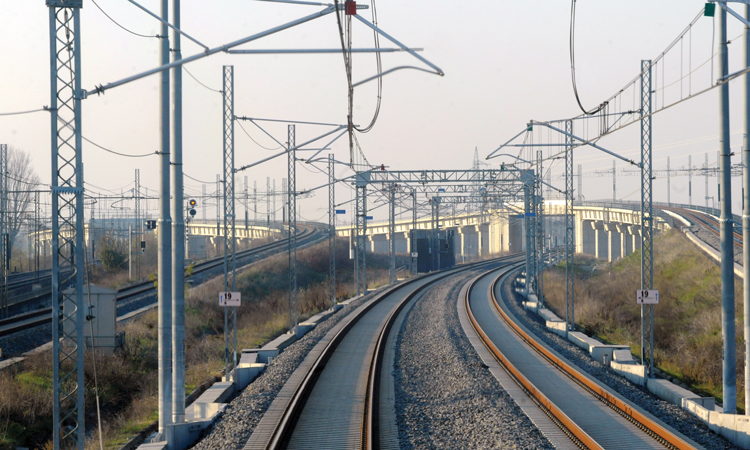Current ERTMS/ETCS operation on the RFI network and future development
Posted: 17 February 2015 | Fabio Senesi - RFI, Gabriele Ridolfi - RFI | No comments yet
Signalling experts Fabio Senesi and Gabriele Ridolfi from Italy’s railway network owner RFI take a look at the current status of ERTMS/ETCS in Italy, plus examine the future development of signalling systems for the country.


Rete Ferroviaria Italiana (RFI – part of the FS Italiane Group) has played a pioneering role in the deployment of ETCS technology having put into commercial operation in 2005 the first ETCS Level 2 line; the Roma–Napoli high-speed line.
Today, 750km of high-speed lines (operating at 300km/h) are equipped with ETCS Level 2 without lateral signals and without fallback train protection systems providing headway of 5 minutes and potential headways of 2.5 minutes. These lines are run by 180 trains per day operated by two high-speed railways undertakings (the only case in Europe) with a total of 360 locos equipped with ETCS and the Italian class B SCMT legacy system.
Both trackside (RBC) and on-board ETCS subsystems are provided by Ansaldo STS and Alstom Ferroviaria suppliers and they refer to Baseline 2 of ETCS specification in law, according to the Technical Specification for Interoperability (TSI) Control Command Signalling (CCS) Annex A voted on RISC Committee of June 2014, with the exception of the Roma–Napoli line which refers to a previous baseline of the specification having been put in operation earlier.
Strong commitment of RFI and both suppliers
A complete system integration between the subsystems of the two suppliers is granted over all RFI ETCS lines. This result was achieved through a strong commitment of RFI and both suppliers, with the goal to check the common and compatible understanding of ETCS functionalities implemented and the effects of all the possible application conditions exported from one subsystem to the other. The system integration activity has been performed on a theoretical basis and on a test campaign, both in lab and in the field, resulting in the release of an Integration Safety Case signed by both suppliers for each combination of subsystems. RFI together with Italcertifer Notify Body (FS Italiane Group) owns an ETCS test lab in Rome where the target on-board units of both suppliers and the mirror RBCs of each line in operation can dialogue in a test environment.
Also the analysis among ETCS trackside, on-board and GSM-R log file integration and their functional analysis by formal methodology is under development with the aim to investigate in an objective way the possible problem coming from operation.
Recently, RFI lines have also been submitted to the Backward Compatibility Assessment analysis according to the study provided by ERTMS Users Group (consortium of the main European Infrastructure Managers) and by UNISIG (Consortium of the European Signalling Suppliers). The result is that no necessity to introduce technical modifications or National Technical Rules (access constraints) have been raised.
In addition, on TEN RFI conventional lines the legacy system in use since the beginning of this century is SCMT, which is an ATP system integrating continuous coded circuit protection (BAcc) and no continuous (e.g. axle counter) with discontinuous balise protection (RSDD); the other Italian class B system is SSC deployed, starting from 2007, over secondary non-electrified lines and providing an ATP discontinuous protection based on microwave technology.
Starting from the aforementioned scenario, the recent evolution of the regulation framework is going to offer new opportunities and challenges to ETCS. Decision 2012/88/EU strengthens the ban on the evolution of the control command legacy systems and imposes precise constraints on the deployment of ETCS for the eligibility of co-funding. Directive 2012/34/EU (Recast Directive) foresees the introduction of a differentiation of track access charges in order to incentivise the installation of ETCS on-board. The ERTMS MoU of 2012 envisages the release of a new version of the ETCS specification addressing new functionalities such as GPRS and ATO for the end of 2015. Regulation (EU) 642/2014 intends to concentrate the European railway research resources inside Shift2Rail project (1 G€ of co-funding in six years) which includes control command innovation towards satellite application, ATO, high density traffic and moving block application having ETCS as a base.
In this context the next evolution of ETCS is going to provide the following conveniences to RFI and railway undertaking companies:
- Operational and maintenance costs reduction introducing ETCS Level 2 (e.g. centralised temporary speed restriction management, line-side signals reduction, wireless application on low density lines)
- Progressive cost reduction of ETCS constituents due to standardisation and market enlargement thanks to cross-acceptance criteria
- Speed enhancement up to 350km/h on existing ETCS high-speed lines
- Block section length tuning and performances maximisation (braking curve model and GPRS bearer) for high density traffic on main city hubs with the aim to migrate toward moving block application (ETCS Level 3) and Automatic Train Operation (ATO)
- According to an expected Common Safety Method and Common Safety Target approach, the coverage and the legal protection of the European Risk assessment process sharing the Hazard Log which considers feedback at European level
- Qualification for Italferr and Italcertifer, companies belonging to FS Italiane Group looking at the foreign market, in the ETCS field with high repayment in term of experience and curriculum for international calls for tender.
For all the aforementioned reasons, within the horizon 2015-2030, RFI has the plan to deploy ETCS on almost 9,000km including corridors on TEN conventional lines, the high-speed line Roma–Firenze called ‘Direttissima’ (today equipped by coded circuit and operated up to 250km/h) and on main cities high density urban networks.
The migration to ETCS on lines equipped by SCMT is facilitated by the deployment of GSM-R coverage upon the RFI network (today 9,700 out of 16,755km are covered by GSM-R including all high-speed and main lines) and by the forward-looking choice made in the 90s to adopt interoperable technology, such as EUROBALISE and the relevant Encoder, for SCMT application. Due to that, ETCS packets can be added to packet 44 sent by existing balises for the use of the national train control system according to the ETCS protocol, without necessity of adding new balises. This means that SCMT will continue to offer the present protection to trains not equipped by ETCS and it will act as fallback control system for train equipped with ETCS and SCMT STM.
Being the success of the migration to ETCS, in terms of cost reduction and revenues for infrastructure manger and railways undertakings, strictly linked to a coordinated and harmonised trackside and on-board deployment plan, RFI has also financed the specification and the testing of a driver machine interface (DMI) integrating both ETCS and SCMT facilities to make easier the installation of ETCS and STM SCMT on-board side.
The choice of Level 2 rather than Level 1 for the application of ETCS on conventional lines is mainly steered by the necessity to guarantee ETCS trains have at least the same performances of SCMT trains. This means that on lines where the BAcc continuous system is in operation, ETCS Level 2 is the preferable choice whereas on lines where the legacy system provides only discontinuous protection or in large shunting area, ETCS Level 1 could be more profitable especially if old generation interlocking are present and their renewal is not affordable.
On big stations and high density hubs, Level 2 (or still better Level 3 application provided the train integrity functionality to ETCS), together with the new GPRS facilities are the obligatory choice.
According to the Risk Analysis on the application of ETCS Level 1 on RFI lines, the use of release speed set to zero is foreseen in case the switch control is missing or the first track circuit following the signal is not free: due to that, infill functionality becomes necessary and between Radio-Infill and EUROLOOP, RFI has chosen the radio having available the GSM-R coverage and trusting on a more open market.
However, it is in the nature of a discontinuous signalling system the risk of using obsolete information (e.g. a signal put at danger after having passed the relevant warning signal at green). ETCS Level 1 application and SCMT belong to this type of signalling system, SCMT providing almost all ETCS Full Supervision functionalities but with the significant difference that ETCS is an ATC system showing the permitted speed to the driver when in Full Supervision mode. Since the risk of misleading the driver operating while watching the DMI is not acceptable according to the risk assessment criteria in use by RFI, when it played the role of Safety Authority, and today by ANSF (Italian National Railway Safety Agency), ETCS Level 1 application on RFI lines will be implemented with the logic of the section timer and with the Radio Infill refreshing the Movement Authority.
A possible alternative to Level 1 + Radio Infill implementation is given by the Level 1 Limited Supervision functionality which can provide all full supervision facilities without obligation to show the permitted speed to the driver. RFI is going to draw up an agreement with Swiss Railways (SBB) to extend the Limited Supervision on two border segments of freight corridor 1 (Iselle–Domodossola and Ranzo–Luino) belonging to RFI, providing that ETCS Limited Supervision could guarantee the same SCMT protection.
In spite of the large experience gained on ETCS Level 2 on high-speed lines, the implementation of ETCS Level 1 and 2 overlying SCMT on RFI conventional lines with lateral signals will pass through trial sites aiming to consolidate the results of the Risk Analysis and of the preliminary specification phase. The trial sites now in progress are:
- Milano–Treviglio (section of freight corridor 6) for ETCS Level 2 over SCMT/BAcc: 35km electrified double-track line, maximum speed of 180km/h, new generation multi-station interlocking and involvement of one (on-board and trackside) supplier
- Sciara–Cammarata (Sicily) for ETCS Level 1 + Radio Infill over SCMT: 38km electrified single-track line, maximum speed of 130km/h, axle counter, electrical interlocking and involvement of two (on-board and trackside) suppliers.
Looking forward to high density and Level 3 applications, RFI is also involved in the ERSAT Consortium having as a target, within the horizon of two years, the testing and the SIL 4 validation of the use of satellite technology for trains localisation purpose (also in GNSS denied Area such as tunnel) adopting Galileo early services. This project foresees the integration of ETCS system (on-board and trackside) with a multi-bearer (terrestrial and satellite) TLC network to test also Euroradio over IP through field test to be performed on Cagliari–San Gavino (Sardinia) 50km line trial site.
Biography




Issue
Related topics
European Rail Traffic Management System (ERTMS), European Train Control System (ETCS), Infrastructure Developments, Signalling, Control & Communications








